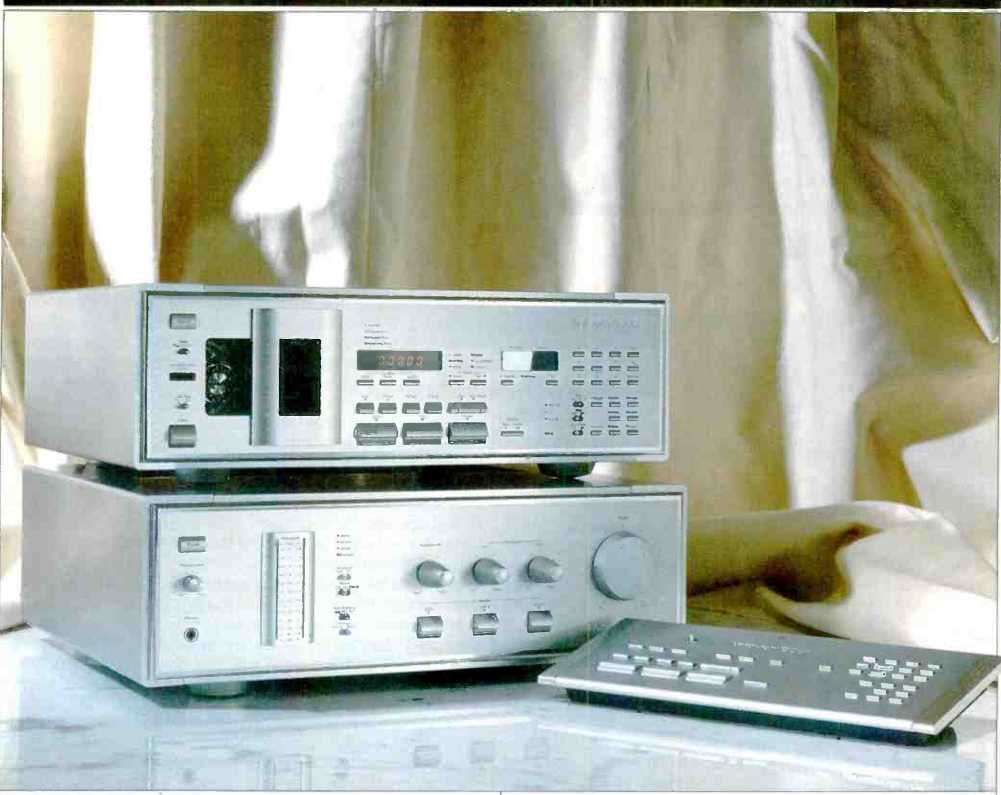
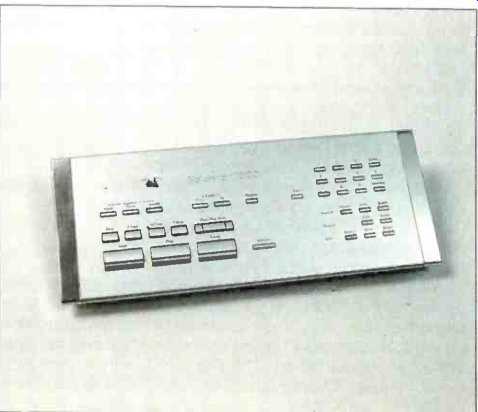
Manufacturer's Specifications:
DAT Recorder
Sampling Frequencies: 48, 44.1, and 32 kHz.
Drum Revolution Speed: 2,000 rpm.
Digital Inputs: 75-ohm coaxial/optical (switchable).
Digital Outputs: 75-ohm coaxial/optical (parallel).
Power Requirements: 120 V a.c., 50 60 Hz, 40 watts.
Dimensions: 17 1/8 in. W x 5 1/4 in. H x 14 9/16 in. D (43.5 cm x 13.3 cm x 37 cm).
Weight: 35 1/4 lbs. (16 kg).
Digital Audio Processor
Sampling Frequencies: A/D converter, 48 kHz; D/A converter, 48, 44.1, and 32 kHz.
Frequency Response: 5 Hz to 22 kHz, ±0.5 dB after A/D and D/A conversion; D/A converter alone, 5 Hz to 20 kHz, ± 0.5 dB.
S/N Ratio (EIAJ): Greater than 95 dB after A/D and D/A conversion; D/A converter alone, greater than 106 dB.
Dynamic Range (EIAJ): Greater than 95 dB after A/D and D/A conversion; D/A converter alone, greater than 100 dB.
THD at 1 kHz: 0.001% after A/D and D/A conversion at 48-kHz sampling rate; D/A converter alone, 0.0005% at 44.1-kHz sampling rate.
THD + N at 1 kHz: 0.003% after A/D and D/A conversion at 48-kHz sampling rate; D/A converter alone, 0.0005% at 44.1-kHz sampling rate.
Channel Separation: Greater than 85 dB after A/D and D/A conversion at 48-kHz sampling rate; D/A converter alone, greater than 106 dB at 44.1-kHz sampling rate.
Digital Inputs: Three optical and 75 ohm coaxial (switch-selected).
Digital Outputs: Two optical and 75-ohm coaxial (parallel).
Analog Line Input Impedances: Balanced, 40 kilohms; unbalanced, 25 kilohms.
Analog Line Input Levels for -18 dB
Recording Level: 50 mV, balanced and unbalanced.
Analog Line Output Impedances: 1 kilohm, balanced or unbalanced, for fixed or variable outputs.
Analog Line Output Levels for 0 dB Recorded Level: Fixed-level outputs, 2 V, balanced or unbalanced; variable outputs, 2 V maximum, balanced or unbalanced.
Headphone Output: 100 mW for 0 dB recorded level, 40-ohm load.
Power Requirements: 120 V a.c., 50/60 Hz, 70 watts.
Dimensions: 17 1/8 in. W x 51/4 in. H x 14 9/16 in. D (43.5 cm x 13.3 cm x 37 cm).
Weight: 38 1/2 lbs. (17.5 kg).
Remote Controller:
Power Supply: 3 V d.c. (two AA batteries).
Dimensions: 12 1/16 in. W x 1 3/4 in. H x 4 3/16 in. D (30.7 cm x 4.4 cm x 12.3 cm).
Weight: 2 lbs. (0.92 kg).
General Specifications:
Price: Entire system, $11,000; recorder alone, $5,900; processor and remote, $5,100.
Company Address: 19701 South Vermont Ave., Torrance, Cal. 90502, USA.
To Nakamichi must go the credit for delivering to this country the first "consumer" DAT recording system, despite the threats of litigation posed by certain record companies and the RIAA. Admittedly, it was not likely that the RIAA would sue someone who sold a DAT recording system for $11,000, but Nakamichi's dedication to technology went beyond politics. They even went beyond the interim recommendations of the DAT Conference and allowed digital input recording at 44.1 kHz.
I can remember when I bought my first Nakamichi Model 1000, the designation given to their then state-of-the-art analog cassette deck. That unit quickly became the cassette deck against which all others were compared. I suspect the same will hold true for the Nakamichi 1000 DAT recording system. By the time you read this, the three-year battle between the audio component makers and American record companies will have been resolved. The new requirements called for by this accord can probably be easily retrofitted into a Nakamichi 1000 DAT system, since the unit is constructed and designed to allow changes or enhancements to the DAT format without expensive modifications.
The system consists o' three separate units: The Nakamichi 1000 DAT recorder, the 1000p digital audio processor, and the 1000r remote control. Because the processor and remote can control up to two recorder units, users can add a second recorder section, which can be purchased separately. You can also buy just the processor for use as a stand-alone converter with other DAT recorders or CD players equipped with optical or coaxial digital interfaces.
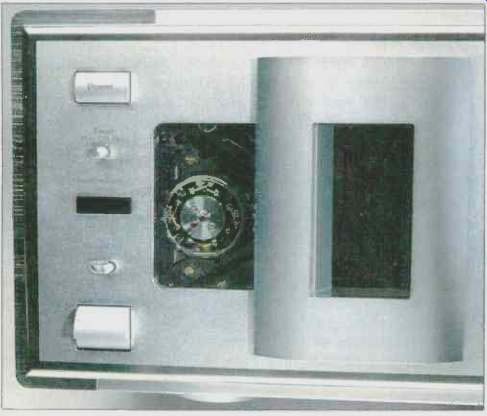

The consumer and professional versions of the 1000 are substantially identical, but the pro version has 19-inch rack mount handles and a wiled remote. It also allows recording at 44.1 or 48 kHz from analog sources (the home version only records at 48 kHz from analog) and conforms to studio standard analog line input and output levels. Both versions feature balanced (XLR-type) as well as unbalanced analog inputs and outputs.
There are so many unique features in the 1000 system, one hardly knows where to begin. Nakamichi's F.A.S.T. (Fast Access Stationary tape guide transport) mechanism is included. According to Nakamichi, it offers greater tape travel precision than other DAT mechanisms which derive their tape transport systems from VCR technology, and it takes less than 2S to load a tape. This system also permits a "half-load" position, in which the tape is lifted off the rotary head drum. This permits fast winding at 400 times normal play speed (twice as fast as with most other DAT machines) and reduces head and tape wear as well.
Perhaps the most outstanding feature of the 1000, from the user's point of view, is its four-head design. This is the first and only consumer DAT recorder to permit true, off-the tape monitoring much like that found in three-head analog tape recorders.
The 1000p processor unit uses an eight-times oversampling, 20-bit D/A converter. There are no sample-and-hold circuits in any portion of the D/A circuitry. The required precision in the D/A converter is achieved through the use of calibration ROM chips. Two low-glitch, 16-bit converter integrated circuits are used for each channel, each pre measured at the factory, according to Nakamichi. Error data is recorded on the ROM chips, which are then installed in each 1000p along with their corresponding converter ICs to provide compensation data. Digital glitch-cancellation circuitry is another contribution from Nakamichi's design staff, as is an automatic calibration technique used with the ND converter. This circuit compares and trims the values of successive bits through a novel additive process. Other refinements in this system will become evident as we discuss the control functions on the system's two main units.
Control Layout
A power switch, timer switch (used with an external timer), "Auto Play" switch, and "Eject" button are all at the left end of the recorder's elegantly finished silver-gray front panel.
The door-loading cassette compartment accepts DAT cassettes oriented vertically, rather than by the usual horizontal drawer arrangement. When the door is closed, windows permit you to view the slowly rotating tape (a DAT moves along at a mere 8.15 mm/S) and also let you see the spinning head drum mechanism in action.
Large, light-touch pushbuttons handle "Stop," "Play," and "Pause" functions, while above these are smaller buttons used to rewind, fast forward, reverse skip, or forward skip the tape from selection to selection. Above and to the right of the cassette door are a counter display and three small associated buttons. The counter will display as an arbitrary five-digit counter, in program time (from the start of the current selection), in remaining time available on the tape, or in absolute time from the tape's start. Indicator lights above the display tell you which counter mode is currently in use. Other small indicator lights nearby show the current digital sampling rate, whether the current signal was recorded with pre-emphasis, whether it is a digital source, and whether the digital signal contains a copy-prohibit subcode flag bit. (Other home DAT decks will not go into recording mode when they detect this bit, but the Nakamichi will continue to record the entire signal-including the copy prohibit flag and other subcode bits.) Just below these indicator lights are "Down" and "Up" buttons for a digital fader. This allows digital signals to be faded in and out as you record them. (DAT decks' analog level controls do not affect the digital input bit stream.) Two fading speeds are available--slow if you just tap the button, faster if you hold it down-but the automated fades cannot be stopped halfway.
Moving a bit to the right, a second display window shows the number of the selection being played and, during search modes, the number selected by the numeric keys to the right of the display (or by the forward and reverse "Skip" buttons). If playing a program, this display shows how far along you are. Just below this window are a "Repeat" button and indicator light, a "Memory" LED, and a "Call" button (which is used to display the memorized program). Farther to the right are the numeric buttons for programmed playback and direct accessing of numbered tracks.
Below the display area and programming buttons are the source/monitor button and, farther to the right, three rows of controls and switches for setting and erasing start and skip IDs and end marks. The top row starts with the "Start ID" indicator LED, followed by the "Auto" switch and buttons to renumber, write, and erase ID codes. The switch sets the unit to record start IDs whenever the level falls for a time below -40 or 60 dB (not all DAT decks offer this choice), or turns the auto-ID feature off. The "Skip ID" row has a switch to enable or disable the skip-ID mode in playback, plus buttons to write and erase codes. The bottom row, controlling end marks, features an on/off switch for automatic rewind, a "Search" button which finds the end ID marking the last recorded portion of the tape, and buttons for "Write" and "Erase."
The rear panel is equipped with digital inputs and outputs but no analog connections (analog signals must go through the 1000p processor or an equivalent). A switch between the jacks selects either the optical or coaxial digital input, but both the coaxial and optical outputs are live simultaneously. Above these jacks are "Remote" input and output jacks for the pro version's wired remote, plus a "DAT 1/DAT 2" address-selector switch. The 1000r remote control has a similar switch so that, when two decks are used at once, it can operate both decks together or either one separately, depending on the switch settings used. This remote control, supplied with the recorder, duplicates virtually all the control and transport functions found on the front panel of the recorder itself.
The companion 1000p digital audio processor is styled to match the recorder component. At the left are its power switch, a headphone jack, and a headphone level control. Vertically oriented peak-level LED meters (which read the signal in the digital domain) are nearby. Further to the right are sampling-rate and pre-emphasis indicator lights and toggle switches for source selection (digital or analog), DAT dubbing, meter indication (off, on, or peak hold), and pre emphasis on/off (used when making recordings via the analog inputs). An output level control and left and right record level controls are positioned above three light-touch buttons that select "DAT 1," "DAT 2," or "Source." At the right is a large master record level control.
The rear panel carries coaxial and optical digital input and output jacks for two DAT recorders, plus optical and coaxial inputs for a CD player or other digital source; a switch selects the optical or coaxial input, in each case. On the analog side, there are both balanced (XLR-type) and unbalanced (phono) connections; a switch selects either the XLR or phono inputs. The output section has both fixed level and variable phono jacks, plus a switch to select fixed or variable operation of the balanced connections. Also on the rear panel are two unswitched a.c. convenience outlets and the power cord.
Nakamichi supplies one pair each of glass optical cables and coaxial digital cables, and two pairs of coaxial analog cables; all coaxial cables are of linear-crystal, oxygen-free copper. A music cassette, a blank R-120, a cleaning cassette, and a cleaning cloth are also provided.
Measurements
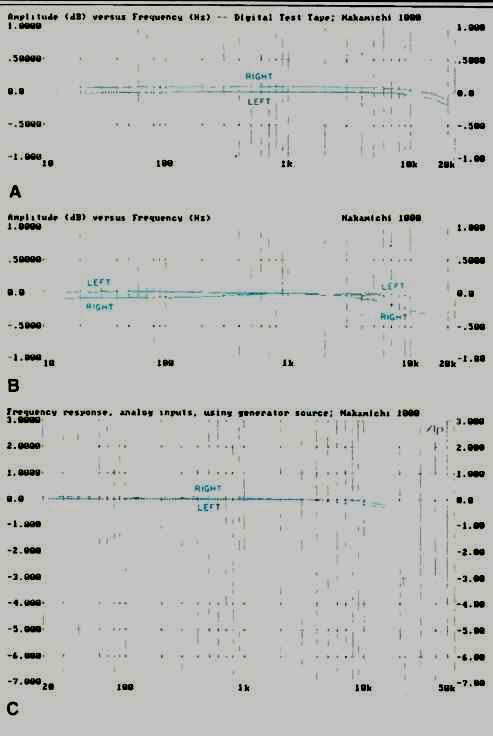
Fig. 1--Frequency response for playback of digital test tape (A) and for record/play,
via analog inputs, from CD player (B) and from external test generator (C).
In 1 A, the right-channel curve was displaced for clarity.

Fig. 2--Interchannel phase difference for record/play via digital inputs (A)
and analog inputs (B).

Fig. 3A--THD + N vs. recording level for record/ play via digital and analog
inputs, using a CD player as a source.

Fig. 3B--Effect of excessive level on a digital recording. Note the sharp
rise in THD + N just above 0-dB recording level. Source was a test generator,
recorded via the analog inputs.
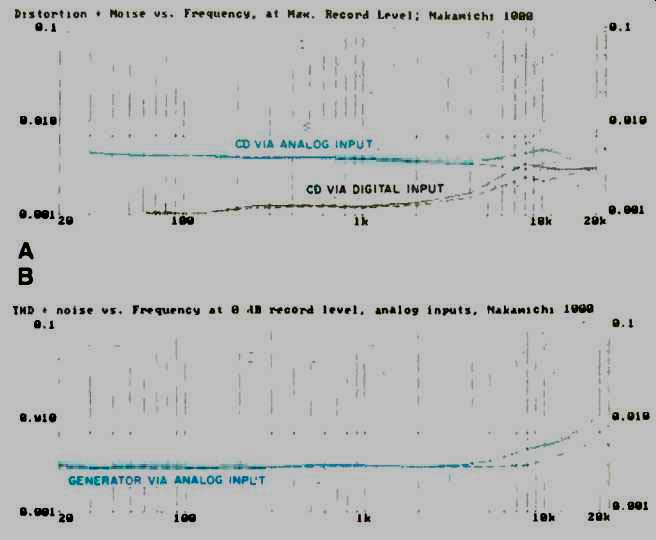
Fig. 4--Record/playback THD + N vs. frequency at 0-dB level, for CD via analog
and digital inputs (A) and for the test generator via analog input (B).
In some ways, measuring a DAT recorder is very much like measuring a CD player. In fact, many of the same tests found on my standard CBS CD-1 test disc are useful in measuring both. Some time ago, I managed to obtain a DAT equivalent of the CD-1 test disc and have used it in checking car DAT players. Because the Nakamichi 1000 is able to record program material at 44.1 kHz through its digital inputs, I was able to measure the performance of this magnificent system much as I would a three-head tape recorder. In other words, I was able to record the contents of my CD-1 test disc onto digital tape and, while doing so, measure the playback of that tape using the tape monitoring feature of the Nakamichi 1000. In addition, I felt it necessary to assess the performance of the system using its analog inputs. For these tests, I employed two types of program source. First, I played the CD-1 test disc on my reference CD player and connected its analog outputs to the Nakamichi's analog input jacks. Then I used the generator portion of my Audio Precision test system as a source. In each case, the 1000's tape monitor let me plot test results as the tape was being recorded.
Now, I recognize that when I taped from my CD player, I was really reading the combined performance of the D/A conversion system of my reference CD player plus the performance of the ND conversion system in the Nakamichi processor. My purpose in making these measurements, however, was to show how much degradation the resulting recording would contain if users were permanently restrained from making digital-to-digital recordings. As we now know, the compromise reached between software and hardware makers a few months ago will make it possible for those of us who buy DAT recorders to make digital-to-digital recordings.

Fig. 5--Third-octave spectrum analyses of residual noise vs. frequency, for
playback of digitally dubbed test signal and for record/play via analog inputs.
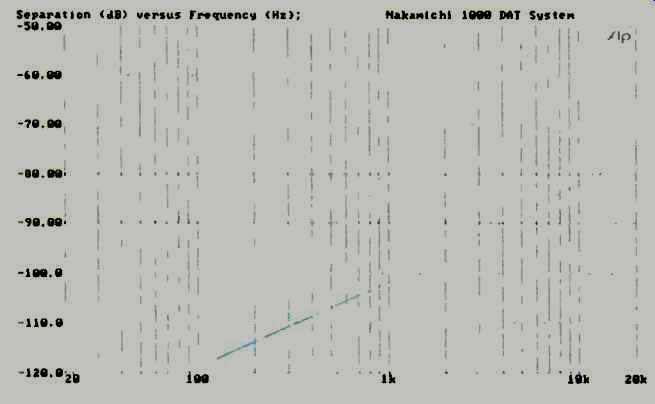
Fig. 6--Separation vs. frequency for record / playback. Separation was identical
in either direction (left to right or right to left) and for recording via
either analog or digital inputs.
To show the analog input performance of the Nakamichi alone, ignoring the impact of any possible defects in the analog source signal, I used the test generator in my Audio Precision system to simulate an analog input source other than CD. This enabled me to illustrate the difference in quality between recordings made wholly in the digital domain and those made via the analog inputs.
Figure 1A shows the record/play frequency response of the Nakamichi 1000 system, using the digital inputs to record the contents of my CD-1 test disc, in the digital domain, from the digital outputs of my reference CD player. Response was down -0.27 dB at 20 kHz for both channels. (Upper curve, for the right channel, was deliberately displaced for clarity.) By way of comparison, Fig. 1B shows the response when the analog line outputs from my reference CD player were connected to the analog inputs of the Nakamichi DAT system. Response, while still relatively flat across the audio spectrum, was now down a bit more than 0.5 dB at 20 kHz. A separate measurement at the output of my reference CD player revealed that much of the difference (the added roll-off) could be attributed to the CD player providing the signal.
Figure 10 was plotted using the signal generator of the Audio Precision test system. Measurements were made in much the same way as they would be for a three-head analog tape deck. Since the sampling frequency was 48 kHz in this test, you will notice that response actually extends very slightly beyond 20 kHz before the steep roll off, which is required to prevent aliasing, occurs.
Just for the record, I measured the phase difference between the two channels, using the digital-to-digital interface (Fig. 2A) as well as the analog inputs (Fig. 2B). There is virtually no difference between the two curves, though to be precise, there is a bit of phase error (no more than a degree or two) at 20 kHz when the test was made via the analog inputs.
Figure 3A is a plot of THD + N versus recording level. Values of THD + N are expressed in dB, relative to maximum level (0 dB). For levels of-20 dB and lower, THD + N via the digital inputs measured about -100 dB or less, or 0.001%-about as low as my test system can measure. At 0-dB levels, the analog output stages must have contributed a slight amount of extra THD, so the reading increased to about -98 dB, or 0.00125%. Compare these results with those obtained when I played the test disc via the analog outputs of my CD player connected to the analog inputs of the DAT recorder: Typically, the readings were about -89 dB at 0-dB level, or around 0.0035%. Once again, I must remind you that much of this added distortion may well be coming from the CD player and not from the record/play cycle of the DAT recorder. As proof of this, and in order to illustrate the "brick wall" limitations of over-recording in the digital domain, I used the Audio Precision test generator to plot THD + N versus recording level in Fig. 3B, from -10 dB to +6 dB. At 0-dB recording level, THD + N was 0.003%-less than when measured using the CD-1 test disc as a source via the analog inputs to the DAT recorder. But more significantly, notice what happens to THD + N at about +0.6 dB: It rises steeply as the system runs out of bits with which to describe the increased level.
Here is harder clipping than you've ever seen from an audio amplifier! As professional users of digital recording equipment have learned, and as we amateurs will have to learn as we make the transition, digital recorders are completely unforgiving of any over-recording. One of the nice things about being able to transfer program material in the digital to-digital mode is that you don't have to worry about level setting; the "zeros" and "ones" of the original recording are simply dubbed to the copy.
Figure 4 shows how THD + N varied with frequency for recordings made at 0-dB level when feeding digital to digital, taping CD via the analog inputs (Fig. 4A), and recording from an external generator via the analog inputs (Fig. 4B). The reading obtained for the digital-to-digital recording is the lowest I have ever measured for this test, whether for a CD player or a DAT machine. As expected, THD + N was a bit higher when the analog inputs were used, but it was still so low at all audio frequencies as to be audibly insignificant.
Measurements of S/N proved particularly interesting. With the "silent" track of my CD-1 test tape recorded digitally and played back by the Nakamichi 1000, I obtained A-weighted S/N figures of 113.4 dB for the left channel and 114.0 dB for the right. When the "silent" recording was made via the analog inputs-again combined with any noise delivered at the analog outputs of the reference CD player-the readings dropped to 94.5 dB for the left channel and 93.6 dB for the right. Spot measurements of EIAJ dynamic range yielded similar differences between digital-to-digital and analog to-digital tests. For the all-digital tests, EIAJ dynamic range measured between 101.4 and 101.7 dB. When I fed the test signal from the analog outputs of my CD player to the DAT's analog inputs, dynamic range decreased to between 87.1 and 89.1 dB. I measured SMPTE-IM distortion of 0.0029% on both channels for digital-to-digital record/playback; using analog-to-digital record/playback, SMPTE IM increased to 0.01%.
Some interesting data is revealed in Fig. 5, which shows spectrum analysis plots of residual noise versus frequency. In the lower plot, for playback of a digitally recorded test tape, you can see that noise level hardly varied with frequency and was generally better than 120 dB below maximum recorded level. By contrast, a recording of the CD-1 test disc's "silent" track, with the digital outputs of a CD player hooked into the Nakamichi's digital inputs, yielded a noise characteristic which increased with frequency, reaching the-100 dB level at 20 kHz (top curve).
Figure 6 is a plot of separation versus frequency and was actually plotted two ways: While making (and monitoring) a digital-to-digital recording and while feeding signals into the DAT machine from my CD player, using analog outputs and inputs. I was somewhat surprised to find that the results of the two tests were identical. This suggests that any crosstalk observed at the higher frequencies can be attributed either to capacitive coupling within the output analog stages and circuitry of the Nakamichi 1000 or, more likely, capacitive coupling between the twin audio output cables connected to my test equipment. In any case, separation at 1 kHz measured more than 100 dB in both tests, decreasing to around 78 dB at 16 kHz.
Deviation from perfect linearity in playback, using undithered signals from my CD-1 test disc recorded digitally onto a DAT tape and played back by the Nakamichi 1000, is shown in Fig. 7A. The results are as good as I have ever seen from a CD player. Bear in mind that, in this instance, only the D/A conversion system of the Nakamichi 1000 is being exercised, since the ND portion of the 1000p processor was not involved. I repeated the test, this time using the analog outputs of my CD player to feed the analog inputs of the Nakamichi 1000 system (Fig. 7B). The resulting departure from perfect linearity should not be attributed solely to the Nakamichi unit under test. Remember, the D/A converters of the CD player are involved, as are the ND converters of the Nakamichi recorder.
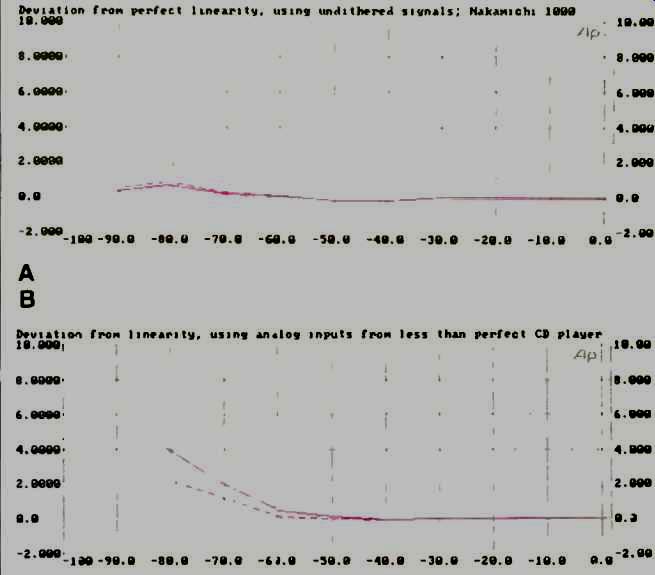
Fig. 7--Deviation from perfect linearity, using undithered signals, for record/play
via the digital (A) and analog (B) inputs. The errors in 7B probably come primarily
from the CD player; see text.

Fig. 8--Deviation from perfect linearity for record/play via digital inputs,
using low-level dithered signals.
Figure 8 shows how minimal the deviation from perfect linearity was when low-level dithered signals were recorded, in the digital-to-digital mode, from 70 to 100 dB. Having already seen how great an influence the CD player's analog outputs were when measuring deviation from linearity for the higher level undithered signals, I saw no point in repeating the corresponding analog-to-digital test for these lower level dithered signals.
The only other spot measurement I made before turning to more pleasurable DAT recording pursuits was to check clock-frequency accuracy of the recorder/player by recording a 20-kHz test tone using digital-to-digital transfer. Even though this test was made entirely in the digital domain, it is possible that the minute error in clock accuracy observed (it was -0.0159%) might be a combination of CD player clock-frequency error and any error in the clock frequency of the DAT recorder/player. In any event, an error of this magnitude means that a 440-Hz tone (middle A in a musical scale) would be reproduced during playback at a frequency of 439.93 Hz. I know of no musician who can detect so insignificant a pitch change.
Use and Listening Tests
My biggest delight in making a few recordings with this superb system was in being able to monitor the taped results, as I do with the reference Nakamichi 700ZXL analog cassette deck that has served me so well over the years. I confess that when I first started testing DAT recorders a couple of years ago (when we thought they would be reaching these shores at any moment), one of my chief disappointments was that, as great as this new recording technology was, there was little hope we would be able to do monitoring in the same way we had with three-head analog open-reel and, later, compact analog cassette decks. The rotating-head technology of the DAT format was primarily borrowed from VCR design, and no one had ever built a VCR that permitted tape monitoring as recordings were being made. It seemed to me that, given the digital recording system's intolerance for over-recording, monitoring would be an especially useful feature for a consumer DAT recorder. I should have known that Nakamichi would figure out a way to mount four heads in the rotating drum of their DAT recorder system, and so they have.
The graphs and numbers speak for themselves. Everything I was able to record while in all-too-temporary possession of this magnificent digital recording system sounded great when played back on my reference system. My regret was that the Nakamichi recorder/player is so big and heavy that it was not practical for me to take it to a concert where I might have gotten permission to do some live instrumental recording. As it was, I was only able to transcribe a few of my favorite CDs--using the digital-to-digital interface--onto tapes I now will be able to play in my car. (Yes, my car has been equipped with a DAT player for more than a year now, and no pothole or bump in the road has ever caused me to miss a note of music!) Now that the DAT controversy has been resolved to the satisfaction of both the record companies and the hardware makers, the latter can look to the Nakamichi 1000 for inspiration as they gear up for second and third-generation DAT recorders that more of us will be able to afford. Still, if you want the definitive DAT recorder and money is no object, the one to buy is the Nakamichi 1000. This equipment definitely merits the "1000" model designation Nakamichi has reserved for its very best efforts.
--Leonard Feldman
(Source: Audio magazine, Nov. 1989)
Also see:
Sony DTC-75ES DAT Recorder (Equip. Profile, Nov. 1990)
Sony TCD-D3 DAT Walkman Recorder (Jan. 1991)
Akai AD-93 (DAT) Digital Audio Tape Recorder (Jun. 1988)
DECIDING ON DAT: Witness of the Persecution (Mar. 1988)
= = = =